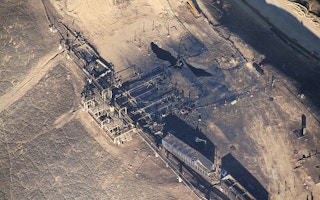The tens of thousands of tonnes of natural gas that surged into the southern California sky late last year were supposed to have fueled the region’s power plants and heated its homes.
Instead, the massive leak at the Aliso Canyon storage site left California electricity providers racing to replace the lost supplies to avoid blackouts and recurring outages in the coming months.
But Los Angeles area utilities aren’t solely seeking more fossil fuels to fill the gap in natural gas. They are also turning to “virtual power plants”: sprawling networks of independent batteries, solar panels, and energy-efficient buildings that are tied together and remotely controlled by software and data systems.
The goal of these virtual power plants is to collectively reduce customers’ energy demand at peak hours and provide renewable energy supplies in targeted areas. This would allow utilities to offset some of the needs for power from conventional sources and avoid disruption on the grid.
Energy experts say that the ongoing response to California’s natural gas shortfall may serve as a high-profile test case for virtual power plants, an emerging field of clean energy that is projected to more than quintuple in size in the United States within a decade; rising from about 4,800 megawatts in capacity in 2014, to nearly 28,000 megawatts by 2023, according to Navigant Research, a consulting and market research firm.
Power providers in the US and Europe are increasingly experimenting with these systems to help manage and harness the value of thousands of distributed energy systems – the various energy storage, efficiency, and renewable energy installations scattered across the grid.
“
The whole notion that utilities are transitioning into a decentralised system is where this interest in virtual power plants and other technologies has really emerged.
Omar Saadeh, senior analyst, GTM Research
“There’s been a significant up-tick in interest from utilities and other power-sector shareholders to deploy these solutions for their different needs,” said Omar Saadeh, a San Francisco-based senior analyst at GTM Research.
Propelling this demand overall is the nation’s ongoing shift away from a centralised electricity market — where hulking, fossil fuel-fired power plants send electrons across state borders via transmission lines — toward a network of localised and lower-carbon supplies, Saadeh said.
“The whole notion that utilities are transitioning into a decentralised system is where this interest in virtual power plants and other technologies has really emerged,” he added.
GTM Research projects that just the software component of virtual power plants – known as “distributed energy resource management systems” – will soon double in market value, from roughly US$50 million (332 million yuan) in 2014 to US$110 million in 2018.
Add in the renewable energy technology, batteries, and other components, and the virtual power plant market could grow from US$1.5 billion in annual revenue in 2016 to a US$5.3 billion market by 2023, with the US taking US$3.7 billion of that year’s total and Europe snagging US$1.3 billion, Navigant projected in 2014.
Peter Asmus, principal research analyst for Navigant in San Francisco, said the market may actually be worth much more, given the recent growth in residential and commercial battery systems from companies such as LG Chem and Panasonic.
In California, the gas shortfall resulting from the Aliso Canyon leak is speeding the adoption of these emerging energy technologies. The California Public Utilities Commission in late May ordered Southern California Edison (SCE), the region’s main power provider, to “expedite its purchase of energy storage” this summer to help “alleviate the electric reliability risks to the Los Angeles Basin,” a process that’s still ongoing. Utility commissioners also asked SCE to hasten the rate at which privately owned batteries, solar, and other distributed systems are connected to the grid.
SCE obtains most of its natural gas supplies from Southern California Gas Company, which owns the underground Aliso Canyon facility that leaked more than 97,000 metric tonnes of methane from late October 2015 through mid-February this year. Only about 15 billion cubic feet, or less than one-fifth of the facility’s capacity, remains available for electricity and heating service in the region, California regulators estimated.
Stem Inc., an energy storage provider, says it expects to accelerate some of its existing virtual power plant projects in the Los Angeles area as a result of California’s response efforts.
This article was written by Maria Gallucci and originally published by Yale360 and republished with permission by Chinadialogue.com Read the full story.










